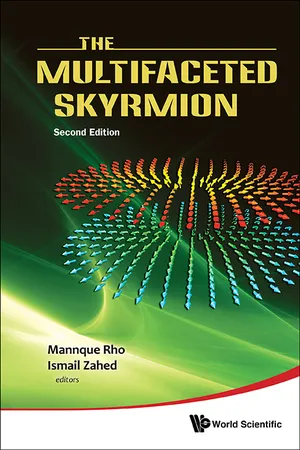
- English
- ePUB (mobile friendly)
- Available on iOS & Android
Multifaceted Skyrmion, The (Second Edition)
About This Book
-->
This book presents, in the form of reviews by world's leading physicists in wide-ranging fields in theoretical physics, the influence and prescience of Skyrme's daring idea of 1960, originally conceived for nuclear physics, that fermions can arise from bosons via topological solitons, pervasively playing a powerful role in wide-ranging areas of physics, from nuclear/astrophysics, to particle physics, to string theory and to condensed matter physics.
The skyrmion description, both from gauge theory and from gauge/gravity duality, offers solutions to some long-standing and extremely difficult problems at high baryonic density, inaccessible by QCD proper. It also offers explanations and makes startling predictions for fascinating new phenomena in condensed matter systems. In both cases, what is at the core is the topology although the phenomena are drastically different, even involving different spacetime dimensions.
This second edition has been expanded with addition of new reviews and extensively updated to take into account the latest developments in the field.
--> Contents:
- Hadrons and Nuclear Matter:
- Skyrmions and Nuclei (R A Battye, N S Manton and P M Sutcliffe)
- States of Carbon-12 in the Skyrme Model (P H C Lau and N S Manton)
- Electromagnetic Form Factors of the Nucleon in Chiral Soliton Models (G Holzwarth)
- Exotic Baryon Resonances in the Skyrme Model (D Diakonov and V Petrov)
- Heavy-Quark Skyrmions (N N Scoccola)
- Pentaquark Candidates P + c (4380) and P + c (4450) within the Soliton Picture of Baryons (N N Scoccola, D O Riska and M Rho)
- Skyrmion Approach to Finite Density and Temperature (B-Y Park and V Vento)
- Fractionized Skyrmions in Dense Compact-Star Matter (M Harada, Y-L Ma, H K Lee and M Rho)
- The Skyrme Model in the BPS Limit (C Adam, C Naya, J Sánchez-Guillén, R Vazquez and A Wereszczyński)
- Superqualitons: Baryons in Dense QCD (D K Hong)
- Condensed Matter:
- Rotational Symmetry Breaking in Baby Skyrme Models (M Karliner and I Hen)
- Emergent Gauge Fields and Their Nonperturbative Effects in Correlated Electrons (K-S Kim and A Tanaka)
- Spin and Isospin: Exotic Order in Quantum Hall Ferromanets (S M Girvin)
- Noncommutative Skyrmions in Quantum Hall Systems (Z F Ezawa and G Tsitsishvili)
- Meron-Pair Excitations in Bilayer Quantum Hall System (K Moon)
- Spin and Pseudospin Textures in Quantum Hall Systems (H A Fertig and L Brey)
- Half-Skyrmion Theory for High-Temperature Superconductivity (T Morinari)
- Deconfined Quantum Critical Points (T Senthil, A Vishwanath, L Balents, S Sachdev and M P A Fisher)
- Skyrmions in a Density-Wave State: A Mechanism for Chiral Superconductivity (S Chakravarty and C-H Hsu)
- String Theory:
- Skyrmion and String Theory (S Sugimoto)
- Holographic Baryons (P Yi)
- The Cheshire Cat Principle from Holography (H B Nielsen and I Zahed)
- Baryon Physics in a Five-Dimensional Model of Hadrons (A Pomarol and A Wulzer)
- Holographic Skyrmions (P M Sutcliffe)
- Holographic Baryons and Instanton Crystal (V Kaplunovsky, D Melnikov and J Sonnenschein)
--> -->
Readership: Research scientists in the fields of condensed matter physics, nuclear and particle physics, and string theory.
--> Key Features:
- Written by leading experts in the fields
- Only book of review on current development of the matter, its pervasiveness in many fields of physics
Frequently asked questions
Information
Chapter 11
Rotational Symmetry Breaking in Baby Skyrme Models
Tel-Aviv University, Tel-Aviv 69978, Israel
[email protected]


Table of contents
- Cover
- Halftitle
- Title
- Copyright
- Preface
- Contents
- Introduction
- Hadrons and Nuclear Matter
- Condensed Matter
- String Theory
- Author Index
- Subject Index